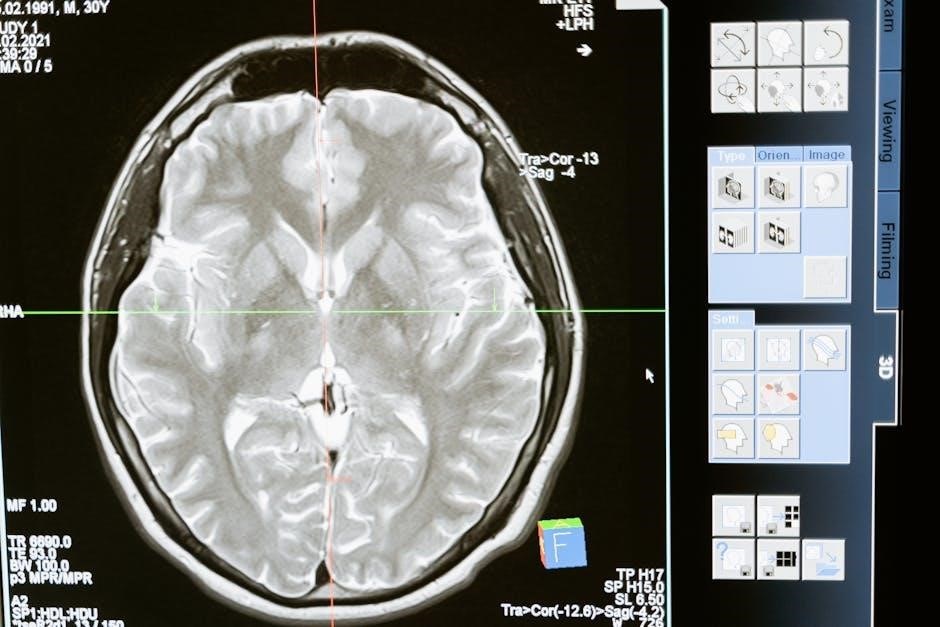Electrocardiography (EKG) is a vital tool for assessing cardiac function, providing insights into heart rhythm, axis, and potential abnormalities. Dale Dubin’s guide offers a structured approach for rapid, accurate interpretation, essential for diagnosing conditions like arrhythmias and ischemia. This non-invasive method is crucial in emergency medicine and routine check-ups, aiding healthcare providers in making timely, informed decisions. The guide’s efficiency and clarity make it indispensable for both novice and experienced practitioners, ensuring precise EKG analysis in high-pressure environments.
1.1 Historical Background of EKGs
The electrocardiogram (EKG) has a rich history dating back to the late 19th century. Willem Einthoven, a Dutch physician, invented the first practical EKG machine in 1903, using a string galvanometer to record the heart’s electrical activity. His work laid the foundation for modern EKG interpretation. Over the 20th century, advancements in technology improved the accuracy and accessibility of EKGs, making them a cornerstone in diagnosing cardiovascular diseases. Today, EKGs remain a vital tool in rapid patient assessment and cardiac care.
1.2 Importance of EKGs in Medical Practice
EKGs are a cornerstone in medical practice, providing non-invasive insights into cardiac function. They are essential for diagnosing arrhythmias, ischemia, and structural heart diseases. EKGs guide urgent treatments, such as defibrillation or thrombolysis, and monitor drug effects. Their rapid results enable timely clinical decisions, improving patient outcomes. Widely accessible and cost-effective, EKGs are indispensable in emergency, critical care, and routine settings, making them a vital tool for healthcare providers worldwide.

Basic Concepts of EKGs
EKGs record the heart’s electrical activity, essential for identifying rhythms, axis, and intervals. Understanding waveform components and measurements is key to accurate interpretation and diagnosis.
2.1 Understanding the EKG Waveform
The EKG waveform consists of the P wave, QRS complex, and T wave, representing atrial and ventricular electrical activity. The P wave signifies atrial depolarization, while the QRS complex reflects ventricular depolarization. The T wave represents ventricular repolarization. Accurate identification of these components is crucial for diagnosing arrhythmias and conduction abnormalities. Proper measurement of intervals, such as the PR and QT intervals, ensures accurate interpretation. Recognizing normal waveform patterns and deviations is essential for mastering rapid EKG interpretation, enabling healthcare providers to quickly identify potential cardiac issues.
2.2 Electrical Axis and Axis Deviation
The electrical axis represents the direction of the heart’s electrical activity, measured in degrees. A normal axis ranges from -30° to +100°. Left axis deviation (LAD) occurs at -30° to -90°, often indicating left ventricular hypertrophy or bundle branch block. Right axis deviation (RAD) is +100° to +180°, suggesting right ventricular hypertrophy or pulmonary disease. Recognizing axis deviation is critical for diagnosing structural heart abnormalities. Proper calculation using limb leads (I, II, III) ensures accurate interpretation. Axis changes can signal underlying conditions, making it vital for rapid EKG analysis.
2.3 Normal EKG Values and Measurements
Normal EKG values are essential for accurate interpretation. The P wave measures up to 0.11 seconds in duration, with a voltage of ≤1.0 mm in lead II. The PR interval ranges from 0.12 to 0.20 seconds, while the QRS duration is ≤0.12 seconds. The QT interval is up to 0.44 seconds for men and 0.46 seconds for women. Heart rate typically ranges from 60 to 100 bpm. These measurements serve as a baseline for identifying deviations, ensuring rapid and precise assessment of cardiac health and function.

Methods and Techniques for Rapid Interpretation
Mastering rapid EKG interpretation requires a systematic approach, utilizing checklists, pattern recognition, and focused analysis to quickly identify key waveforms and critical measurements in seconds.
3.1 Structured Approach to EKG Analysis
A structured approach to EKG analysis involves systematically evaluating the waveform in a logical sequence. Start by assessing the rate and rhythm, followed by the P wave, QRS complex, and T wave. Measure key intervals, such as the PR, QRS, and QT durations, and note any deviations from normal ranges. Check for axis deviation, hypertrophy, or signs of ischemia. This method ensures all components are reviewed, minimizing the risk of overlooking critical abnormalities. Consistency in this approach enhances accuracy and efficiency in rapid interpretation.
3.2 Using Checklists for Efficiency
Using checklists during EKG analysis ensures a systematic and efficient evaluation. A well-designed checklist covers key components such as rate, rhythm, axis, and intervals. It helps identify abnormalities like bundle branch blocks or hypertrophy. Checklists also prompt reviewers to assess for signs of ischemia or infarction. By following a standardized list, practitioners reduce errors and improve consistency. This tool is particularly beneficial for less experienced interpreters, ensuring no critical findings are overlooked. Regular use enhances speed and accuracy, making checklists indispensable for rapid EKG interpretation.
3.3 The Role of Pattern Recognition
Pattern recognition is a cornerstone of rapid EKG interpretation, enabling quick identification of abnormal waveforms. Experienced practitioners develop the ability to recognize specific patterns, such as P-wave morphology or QRS complexes, which correlate with conditions like atrial enlargement or bundle branch blocks. This skill reduces analysis time and improves accuracy. Common patterns include ST-segment elevation for myocardial infarction or wide QRS tachycardias. Mastery of these patterns allows for efficient and reliable diagnoses, especially in acute settings where timely decisions are critical.

Common EKG Findings
Common EKG findings include normal sinus rhythm, arrhythmias, signs of ischemia, infarction, and hypertrophy. Recognizing these patterns is crucial for rapid, accurate diagnoses and patient care.
4.1 Normal Sinus Rhythm and Variants
A normal sinus rhythm (NSR) is characterized by a heart rate of 60-100 beats per minute, with a consistent P-wave preceding each QRS complex. The P-wave originates from the sinoatrial node, ensuring a normal electrical activation sequence. Variants, such as sinus arrhythmia or wandering atrial pacemaker, may occur but still maintain a normal overall pattern. These rhythms are benign and require no intervention unless associated with clinical symptoms. Recognizing NSR and its variants is foundational for distinguishing normal from pathological findings during rapid EKG interpretation.
4.2 Atrial and Ventricular Hypertrophy
Atrial hypertrophy is indicated by tall P-waves (>2.5mm) in leads I and II for left atrial enlargement, and in leads III and aVR for right atrial enlargement. Ventricular hypertrophy is identified by tall QRS complexes (>30mm in men, >25mm in women) in left precordial leads for left ventricular hypertrophy, or right axis deviation with tall QRS in right leads for right ventricular hypertrophy. These changes reflect increased workload on the heart chambers. Accurate measurement and clinical correlation are essential for diagnosis and management.
4.3 Signs of Ischemia and Infarction
Ischemia on an EKG is indicated by ST-segment depression, T-wave inversion, or dynamic changes during stress. Myocardial infarction is identified by ST-segment elevation (STEMI), Q-waves, or reciprocal ST-depression. Subtle signs include hyperacute T-waves in early infarction or bundle branch blocks. These patterns help localize the area of damage, guiding urgent interventions like reperfusion therapy. Timely recognition of these changes is critical for patient outcomes, emphasizing the need for rapid and accurate EKG interpretation in acute settings.

Arrhythmias and Conduction Disorders
This section covers abnormal heart rhythms, including supraventricular and ventricular arrhythmias, as well as conduction system abnormalities like AV blocks. Key identifying features are discussed for rapid diagnosis.
5.1 Supraventricular Tachycardias (SVTs)
SVTs are rapid heart rhythms originating above the ventricles, often causing symptoms like palpitations, dizziness, or shortness of breath. On an EKG, SVTs are characterized by a rapid, regular rhythm with a narrow QRS complex (<120 ms). Key features include a heart rate >100 bpm, regular rhythm, and absence of P-waves or retrograde P-waves. Common types include paroxysmal supraventricular tachycardia (PSVT) and atrioventricular nodal reentrant tachycardia (AVNRT). Atrial flutter may also present as a regular, rapid rhythm with a “sawtooth” pattern.
5.2 Ventricular Arrhythmias
Ventricular arrhythmias originate in the ventricles, often indicating serious cardiac conditions. Common types include premature ventricular contractions (PVCs), ventricular tachycardia (VT), ventricular fibrillation (VF), and ventricular flutter (VFL). PVCs are typically benign but may signify underlying stress or disease. VT, characterized by three or more consecutive PVCs, can degenerate into VF, a life-threatening rhythm requiring immediate intervention. Key EKG findings include wide QRS complexes, tall T waves, and specific patterns like torsades de pointes. Accurate interpretation is critical, as these arrhythmias often correlate with structural heart disease or electrolyte imbalances. Contextualizing these findings with clinical history is essential for proper management.
5.3 Atrioventricular (AV) Block
The atrioventricular (AV) block occurs when electrical impulses between the atria and ventricles are delayed or blocked. It is classified into three degrees: first-degree (prolonged PR interval), second-degree (intermittent block), and third-degree (complete block with no P-wave conduction). Causes include fibrosis, infarctions, or medications. Symptoms range from asymptomatic to syncope or heart failure. Diagnosis involves identifying specific EKG patterns, such as P waves unrelated to QRS complexes in third-degree blocks. Treatment may involve pacemaker implantation, especially in symptomatic third-degree AV block.

EKG Changes in Systemic Diseases
Systemic diseases often manifest on EKGs through specific patterns. Hypertension may show left ventricular hypertrophy, while pulmonary embolism can cause the S1Q3T3 pattern. Electrolyte imbalances, such as hyperkalemia, lead to tall, peaked T waves, and hypokalemia may flatten T waves or reveal U waves. Recognizing these changes is crucial for rapid diagnosis and treatment.
6.1 EKG Findings in Hypertension
In hypertension, EKG findings may include left ventricular hypertrophy (LVH), characterized by increased QRS voltages in the lateral leads (V5, V6) and deep S waves in the anterior leads (V1, V2). The Sokolow-Lyon criteria (SV1 + RV5/RV6 ≥ 35 mm) can help diagnose LVH. A “strain pattern” may also be present, showing ST-segment depression and T-wave inversion in lateral leads. Additionally, hypertension can cause left atrial enlargement, manifesting as a bifid P wave in lead II. These changes indicate increased cardiac workload and potential target organ damage.
6.2 EKG Changes in Pulmonary Embolism
In pulmonary embolism (PE), the EKG may show signs of right ventricular strain due to increased pulmonary artery pressure. Common findings include sinus tachycardia, which is the most frequent arrhythmia in PE. The classic S1Q3T3 pattern (deep S wave in lead I, Q wave in lead III, and inverted T waves in lead III) may occur but is not sensitive. Other signs include incomplete or complete right bundle branch block and T-wave inversion in the right precordial leads (V1-V4). These changes are not definitive but suggest the need for further diagnostic evaluation, such as CT pulmonary angiography.
6.3 Electrolyte Imbalances and EKG
Electrolyte imbalances significantly impact EKG readings, as they alter the heart’s electrical activity. Common imbalances include hyperkalemia, hypokalemia, hypocalcemia, and hypercalcemia. Hyperkalemia causes tall, peaked T waves and widened QRS complexes, while hypokalemia leads to flattened T waves and U waves. Hypocalcemia prolongs the QT interval, and hypercalcemia shortens it. Magnesium imbalances can also affect T-wave morphology and contribute to arrhythmias. Recognizing these patterns is crucial for rapid interpretation, as they often indicate underlying metabolic issues requiring immediate intervention. Clinical correlation is essential to confirm the cause of EKG changes.

Clinical Applications of EKGs
EKGs are essential in emergency medicine for quickly diagnosing arrhythmias, ischemia, and infarctions. They guide critical care decisions, such as defibrillation or pacing. Preoperative EKGs assess surgical risks.
7.1 EKG in Emergency Medicine
The EKG is a vital tool in emergency medicine, enabling rapid assessment of cardiac conditions. In acute settings, it helps identify life-threatening arrhythmias, ischemia, or infarction. Emergency physicians rely on the EKG to guide immediate interventions, such as reperfusion therapy for STEMI or cardioversion for unstable arrhythmias. Key findings include ST-segment elevation, Q-waves, or bundle branch blocks. Portable devices allow bedside testing, ensuring timely diagnosis and treatment. The EKG’s portability and non-invasive nature make it indispensable in emergencies, aiding in critical decision-making and improving patient outcomes.
- Identifies STEMI, acute coronary syndromes, and arrhythmias.
- Guides immediate interventions like reperfusion therapy.
- Portable and non-invasive, ideal for acute care.
7.2 EKG Monitoring in Critical Care
EKG monitoring in critical care settings is essential for real-time surveillance of cardiac activity in high-risk patients. It allows rapid detection of acute changes, such as ischemia, arrhythmias, or conduction disturbances. Continuous monitoring enables early intervention for life-threatening conditions like STEMI or pulmonary embolism. Additionally, it aids in assessing the effectiveness of treatments and identifying subtle changes in cardiac function. Customizable alerts for dangerous rhythms, such as ventricular tachycardia or atrial fibrillation, enhance patient safety. This tool is vital for optimizing outcomes in critically ill patients, ensuring timely and targeted care.
7.3 Preoperative and Postoperative EKG Assessment
Preoperative and postoperative EKG assessments are crucial for evaluating cardiac risks in surgical patients. They help identify underlying conditions like arrhythmias, ischemia, or conduction abnormalities that may impact surgical outcomes. In the preoperative phase, EKGs assess baseline cardiac function, while postoperative EKGs monitor recovery and detect complications. Abnormal findings, such as ST-segment changes or QT prolongation, can signal ischemia or electrolyte imbalances. These assessments guide anesthesia planning and postoperative care, ensuring patient safety and optimal surgical results. Regular EKG monitoring in these settings is essential for early detection and management of cardiac issues.

Tools and Resources for Learning EKGs
The “Rapid Interpretation of EKGs” PDF by Dale Dubin is a premier resource, offering clear explanations and visual aids for mastering EKG analysis. It includes practice exercises and real-world examples, making it an invaluable tool for both beginners and experienced professionals seeking to refine their skills.
8.1 Dale Dubin’s Rapid Interpretation of EKGs
Dale Dubin’s Rapid Interpretation of EKGs is a seminal resource for mastering EKG analysis. The book provides a systematic approach to identifying patterns, making it easier to diagnose conditions quickly. Dubin’s method emphasizes recognizing waveforms and understanding their clinical implications. The text is enriched with illustrations and case studies, catering to both novices and experienced practitioners. Its focus on practical application has made it a favorite among medical students and professionals seeking to refine their skills in rapid EKG interpretation;
8.2 Online Courses and Tutorials
Online courses and tutorials are excellent resources for mastering rapid EKG interpretation. Platforms like Coursera, Udemy, and edX offer structured programs that cover foundational concepts, waveform analysis, and clinical applications. These courses often include interactive quizzes, case studies, and downloadable materials. Many are designed for healthcare professionals, providing flexible pacing to accommodate busy schedules. They emphasize pattern recognition and practical skills, making them ideal for both beginners and experienced practitioners. These resources are widely accessible and offer a comprehensive approach to learning EKG interpretation effectively.
Additionally, specialized websites and medical education portals provide free and paid tutorials, focusing on specific aspects of EKG analysis. These resources often include video lectures, practice EKG strips, and step-by-step guides. They are particularly useful for reinforcing concepts and staying updated on the latest advancements in EKG technology and interpretation techniques. Online learning tools are invaluable for anyone aiming to improve their proficiency in rapid EKG interpretation in a self-paced and engaging manner.
8.3 Mobile Apps for EKG Learning
Mobile apps have revolutionized EKG learning by providing accessible tools for healthcare professionals. Apps like ECG Tutor and ECG Guide offer interactive lessons and real-time waveform analysis. Rhythm Strip allows users to practice interpreting strips and compare with expert annotations. ECG Pocket Guide provides quick reference materials for common patterns. These apps enable learners to master rapid interpretation skills anytime, anywhere, making them indispensable for medical students and practitioners seeking to enhance their EKG proficiency.

Common Pitfalls in EKG Interpretation
Artifact interference, technical errors, and overlooked subtle changes are frequent pitfalls. Misinterpreting normal variants as pathological and ignoring clinical correlation can lead to diagnostic errors, emphasizing the need for meticulous analysis.
9.1 Misleading Artifacts and Technical Errors
Misleading artifacts and technical errors are common challenges in EKG interpretation. These include electrode misplacement, muscle tremors, electrical interference, and poor skin preparation. Such issues can mimic pathological conditions, leading to misdiagnosis. Technical errors, like incorrect calibration or improper lead placement, further complicate analysis. Recognizing these artifacts is crucial for accurate interpretation. Always ensure proper equipment setup and patient preparation to minimize errors. Careful inspection of the waveform and clinical correlation can help distinguish artifacts from true abnormalities, ensuring reliable rapid EKG interpretation.
9.2 Overlooking Subtle Changes
Subtle changes on an EKG can often be missed, even by experienced interpreters, leading to potential misdiagnoses. These small variations, such as slight ST-segment elevations or minor Q-wave abnormalities, may indicate serious conditions like ischemia or infarction. Factors contributing to oversight include inexperience, fatigue, or rushing through the analysis. A systematic approach, emphasizing careful measurement and comparison to prior tracings, is essential to avoid errors. Using checklists can also help ensure no detail is overlooked, reinforcing the importance of diligence in every interpretation.
9.4 The Role of Clinical Correlation
Clinical correlation is essential for accurate EKG interpretation, ensuring findings align with the patient’s symptoms, history, and physical exam. Without this context, even subtle EKG changes may be misinterpreted. For instance, a nonspecific ST-segment abnormality could indicate ischemia or benign variants, depending on the clinical scenario. Correlating EKG results with patient-specific factors enhances diagnostic accuracy, prevents overdiagnosis, and tailors management strategies effectively. This integration is critical for rapid and reliable interpretation in emergency and critical care settings.
Advanced Topics in EKG Interpretation
Exploring specialized EKG analysis in pediatric and geriatric populations, recognizing unique patterns, and integrating advanced techniques with clinical context for accurate rapid interpretation.
10.1 EKG in Pediatric and Geriatric Populations
The interpretation of EKGs in pediatric and geriatric populations requires special consideration due to physiological differences. In children, normal EKGs often show shorter PR intervals, faster heart rates, and smaller QRS amplitudes. Conditions like congenital heart defects may present unique waveforms. In geriatric patients, age-related changes such as bundle branch blocks or arrhythmias are common. Understanding these variations is crucial for accurate diagnosis, as standard adult criteria may not apply. Age-specific norms must be used to avoid misinterpretation and ensure appropriate clinical decisions.
10.2 EKG in Athletes and Special Populations
Athletes often exhibit unique EKG patterns due to physiological adaptations from intense training. Sinus bradycardia, increased QRS voltages, and early repolarization are common findings. These adaptations can sometimes mimic pathological conditions, requiring careful differentiation. Special populations, such as individuals with disabilities or rare genetic conditions, may also present with distinct EKG features. Correct interpretation is crucial to avoid misdiagnosis and ensure appropriate management. Clinicians must consider the clinical context and correlate findings with symptoms and other diagnostic tools to make accurate assessments.
10.3 EKG in Congenital Heart Diseases
EKG interpretation in congenital heart diseases requires attention to unique patterns. Conditions like atrial septal defects (ASD) may show right axis deviation and rSr’ patterns, while ventricular septal defects (VSD) often present with left ventricular hypertrophy signs. Tetralogy of Fallot typically exhibits right ventricular hypertrophy and a prominent R wave in lead V1. Transposition of the great arteries may show abnormal Q waves and axis deviation. Clinical correlation is essential, as pediatric EKGs may exhibit benign variations. Early recognition of these findings aids in timely diagnosis and management of congenital heart defects.

Future of EKG Technology
The future of EKG technology involves advancements in AI, wearable devices, and remote monitoring, enabling faster and more accurate rapid interpretation of EKGs in various clinical settings.
11.1 AI and Machine Learning in EKG Analysis
Artificial intelligence (AI) and machine learning are revolutionizing EKG interpretation by enhancing accuracy and speed. Deep learning algorithms can analyze vast datasets to identify patterns, enabling rapid detection of abnormalities such as arrhythmias or ischemia. AI-driven tools improve diagnostic consistency, reducing human error. Integration with wearable devices allows continuous monitoring, enabling early detection of cardiac issues. However, reliance on AI requires high-quality training data and ethical considerations to avoid bias. These technologies are transforming EKG analysis, making it more accessible and efficient in clinical practice.
11.2 Wearable Devices and Remote Monitoring
Wearable devices have revolutionized EKG monitoring by enabling real-time, continuous tracking of heart activity outside traditional clinical settings. Smartwatches and portable EKG sensors detect arrhythmias, such as atrial fibrillation, and alert users to potential issues. Remote monitoring systems allow healthcare providers to access patient data remotely, improving timely intervention. These tools are particularly valuable for managing chronic conditions and reducing hospital readmissions. The integration of wearable technology with EKG interpretation enhances early detection of abnormalities, promoting better patient outcomes and streamlining care delivery.
11.3 Integration with Electronic Health Records
The integration of EKGs with electronic health records (EHRs) has revolutionized how cardiovascular data is managed. By embedding EKG waveforms and interpretations directly into patient records, clinicians can access critical information seamlessly. This integration enhances patient care by providing a comprehensive view of medical history, reducing errors, and improving communication among healthcare teams. Automated updates and alerts for abnormal results further streamline workflows, ensuring timely interventions. This digital synergy between EKGs and EHRs is a cornerstone of modern, efficient healthcare systems.
Mastering rapid EKG interpretation is essential for accurate diagnosis and timely patient care. Continuous learning and practice are crucial to refine skills and stay updated on advancements.
12.1 Summary of Key Points
- Mastering waveform analysis is foundational.
- Structured approaches and checklists enhance accuracy.
- Clinical context is vital for accurate interpretation.
These principles underscore the importance of EKG interpretation in patient care.
12.2 Importance of Continuous Learning
Continuous learning is crucial for mastering the rapid interpretation of EKGs, as medical knowledge and technology evolve. Staying updated with new guidelines, research, and advancements ensures accurate and effective patient care. Regular practice and review of EKG cases enhance pattern recognition and diagnostic skills. Incorporating feedback from mentors and peers helps refine interpretation abilities. Lifelong learning fosters confidence and competence, enabling healthcare professionals to provide optimal care in dynamic clinical environments.
12.3 Final Thoughts on Rapid EKG Interpretation
Mastery of rapid EKG interpretation is a skill that enhances patient care and clinical decision-making. By combining a structured approach with pattern recognition, healthcare providers can efficiently identify abnormalities. Continuous learning and practice are essential, as EKGs evolve with advancing technology. Leveraging resources like checklists and digital tools ensures accuracy and speed. Remember, the goal is not just to interpret waves but to connect findings to the patient’s condition. Dedication to this craft will lead to improved outcomes and confident practice.